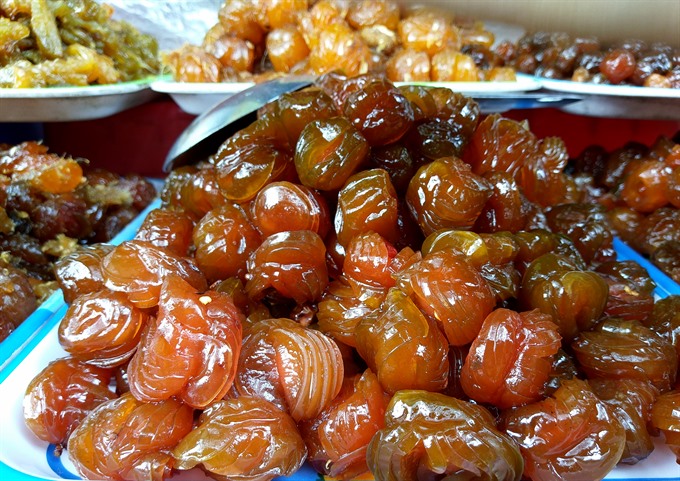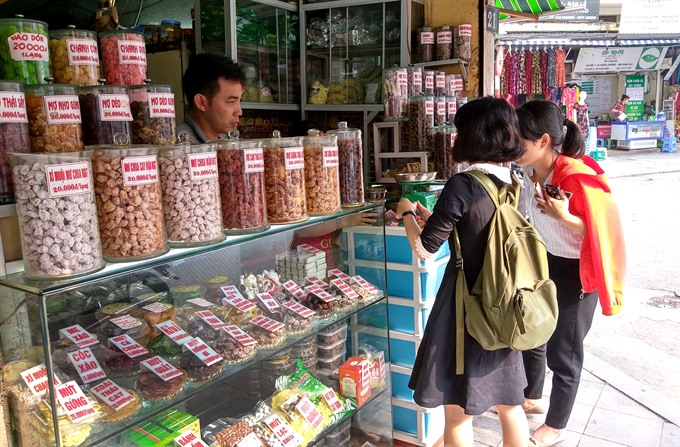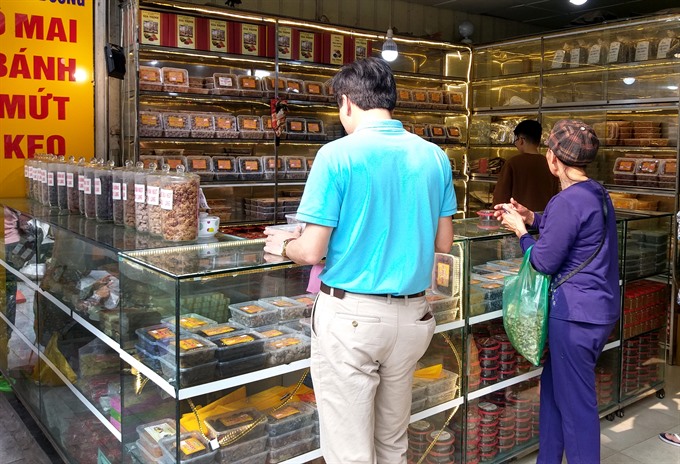Viet Nam News
Hong Van
What started out as a tradition treat in Vietnamese homes has become big business.
O mai is a preserved sugared or salted fruits. A favourite snack to tickle your taste buds during the days of Tet (Vietnamese New Year).
The small cups on the table over flowing with colourful fruits were much more than just a snack. They symbolised the wish for a happy new year for the family
In days gone by selection of fruits used to produce o mai was sparse to say the least. Apricot, plum and sau (dracontomelon) were usually the only fruits in the bowl.
Fast forward to today and o mai has evolved into mass production, providing jobs for many at factories countrywide.
And the choice of fruit is almost endless. Starfruit, ambarella, peach and lemon to name but a few. What’s also expanded is taste and texture. You can now chose from sour, spicy, salty or sweet that can be served either humid or dry.
 |
| A plum choice: Plum is one of the most popular fruits used to make o mai. — VNS Photo Doan Tung |
But the care and effort to produce such a traditional treat has far from fallen. Making o mai involves different stages. First, locals have to check and classify for fruits of same size and high quality, big and smooth fruit without bruising.
Fruits are then cleaned and pricked in order to absorb sugar more easily. Sugar and salt are added along with water flavoured with a hint of lime to maintain the fruit’s natural colour and reduce the bitter taste as well as eliminate microorganisms.
The mixture of fruits in sugar, salt, chilli powder and ginger are then cooked and simmered. This is considered the most important step as it decides the quality of o mai. Different types of fruits require different simmering method and time.
The final stage is having fruits fermented and dried.
To find good o mai, Hanoians would come to Hang Duong Street in the Old Quarter.
 |
| Sweet toothed : Coming to o mai shops, one will be mesmerized with a number of varieties stored in the glass vases – brown, yellow, dark green fruits mixed with ginger thread, chilli powder. — VNS Photo Doan Tung |
This street once had the French name Rue du Sucre (Street of Sugar) until 1945, when the country gained independence.
It’s name was changed but the meaning remained the same when it became Hang Duong (Street of Sugar).
Stretching almost 200 metres long, it took its name from the commodities that were often exchanged, candies and other products all with a sugary theme.
Until 1960s, this was still a centre for candy trade in Ha Noi and a favourite place to find sweets for locals in Full Moon Festival and Vietnamese New Year. Nowadays, there are not many candy shops but other types of commodities yet still a reliable place for good o mai.
Those who visit will be mesmerized with a number of varieties stored in the glass vases – brown, yellow, dark green fruits mixed with ginger thread, chilli powder.
Enough to make mouths water and send those with a sweet tooth rushing to get their fix. .
 |
| O mai oh my: To find good o mai, Hanoians would come to Hang Duong Street in the Old Quarter. — VNS Photo Doan Tung |
Top places for o mai in Ha Noi
Hong Lam and Tien Thinh have well developed from a small family-run business to a large o mai brand which offers a wide range of options. The catchy package and high quality fruit are the selling points of these brands.
The fruit ranges from VND200,000 to 350,000 (US$8.7-15.3) per kilogram, depending on different types.
Van Loi shop, a small family-run business in Hang Da Street is also a must when one wants to buy good o mai in Ha Noi. the price here is a bit lower than Hong Lam, at about VND150,000 to 300,000 ($6.5-13).
“My grandmother lived near the Van Loi shop. When I was small, I visited the shop very often. It costed only 5 to 10,000 (20-40 US cents) for a lot. Every time I came here, I was so excited with so many types of o mai they offer. Thinking of it makes me mouthwatering,” said Nguyen Cam Ly, a 25 year old Hanoian.
When one passes by the Hang Cot Street, they also easily notice an o mai shop named Thuy Khe, which stuffed with colorful bottles of o mai.
O mai xao (stir-fried fruit), which is more humid and chewy than dried fruits, is highlight of this shop.
Products here are favoured for its strong taste and not being too sweet while the flavour of ginger and fruit are well maintained. — VNS